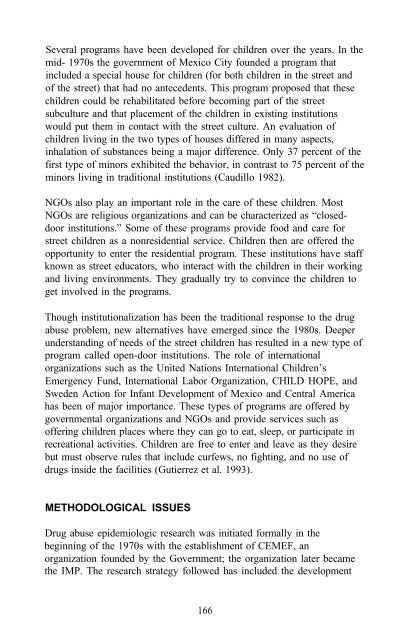Epidemiology of Inhalant Abuse - Archives - National Institute on ...
Epidemiology of Inhalant Abuse - Archives - National Institute on ...
Epidemiology of Inhalant Abuse - Archives - National Institute on ...
You also want an ePaper? Increase the reach of your titles
YUMPU automatically turns print PDFs into web optimized ePapers that Google loves.
Several programs have been developed for children over the years. In the<br />
mid- 1970s the government <str<strong>on</strong>g>of</str<strong>on</strong>g> Mexico City founded a program that<br />
included a special house for children (for both children in the street and<br />
<str<strong>on</strong>g>of</str<strong>on</strong>g> the street) that had no antecedents. This program proposed that these<br />
children could be rehabilitated before becoming part <str<strong>on</strong>g>of</str<strong>on</strong>g> the street<br />
subculture and that placement <str<strong>on</strong>g>of</str<strong>on</strong>g> the children in existing instituti<strong>on</strong>s<br />
would put them in c<strong>on</strong>tact with the street culture. An evaluati<strong>on</strong> <str<strong>on</strong>g>of</str<strong>on</strong>g><br />
children living in the two types <str<strong>on</strong>g>of</str<strong>on</strong>g> houses differed in many aspects,<br />
inhalati<strong>on</strong> <str<strong>on</strong>g>of</str<strong>on</strong>g> substances being a major difference. Only 37 percent <str<strong>on</strong>g>of</str<strong>on</strong>g> the<br />
first type <str<strong>on</strong>g>of</str<strong>on</strong>g> minors exhibited the behavior, in c<strong>on</strong>trast to 75 percent <str<strong>on</strong>g>of</str<strong>on</strong>g> the<br />
minors living in traditi<strong>on</strong>al instituti<strong>on</strong>s (Caudillo 1982).<br />
NGOs also play an important role in the care <str<strong>on</strong>g>of</str<strong>on</strong>g> these children. Most<br />
NGOs are religious organizati<strong>on</strong>s and can be characterized as “closeddoor<br />
instituti<strong>on</strong>s.” Some <str<strong>on</strong>g>of</str<strong>on</strong>g> these programs provide food and care for<br />
street children as a n<strong>on</strong>residential service. Children then are <str<strong>on</strong>g>of</str<strong>on</strong>g>fered the<br />
opportunity to enter the residential program. These instituti<strong>on</strong>s have staff<br />
known as street educators, who interact with the children in their working<br />
and living envir<strong>on</strong>ments. They gradually try to c<strong>on</strong>vince the children to<br />
get involved in the programs.<br />
Though instituti<strong>on</strong>alizati<strong>on</strong> has been the traditi<strong>on</strong>al resp<strong>on</strong>se to the drug<br />
abuse problem, new alternatives have emerged since the 1980s. Deeper<br />
understanding <str<strong>on</strong>g>of</str<strong>on</strong>g> needs <str<strong>on</strong>g>of</str<strong>on</strong>g> the street children has resulted in a new type <str<strong>on</strong>g>of</str<strong>on</strong>g><br />
program called open-door instituti<strong>on</strong>s. The role <str<strong>on</strong>g>of</str<strong>on</strong>g> internati<strong>on</strong>al<br />
organizati<strong>on</strong>s such as the United Nati<strong>on</strong>s Internati<strong>on</strong>al Children’s<br />
Emergency Fund, Internati<strong>on</strong>al Labor Organizati<strong>on</strong>, CHILD HOPE, and<br />
Sweden Acti<strong>on</strong> for Infant Development <str<strong>on</strong>g>of</str<strong>on</strong>g> Mexico and Central America<br />
has been <str<strong>on</strong>g>of</str<strong>on</strong>g> major importance. These types <str<strong>on</strong>g>of</str<strong>on</strong>g> programs are <str<strong>on</strong>g>of</str<strong>on</strong>g>fered by<br />
governmental organizati<strong>on</strong>s and NGOs and provide services such as<br />
<str<strong>on</strong>g>of</str<strong>on</strong>g>fering children places where they can go to eat, sleep, or participate in<br />
recreati<strong>on</strong>al activities. Children are free to enter and leave as they desire<br />
but must observe rules that include curfews, no fighting, and no use <str<strong>on</strong>g>of</str<strong>on</strong>g><br />
drugs inside the facilities (Gutierrez et al. 1993).<br />
METHODOLOGICAL ISSUES<br />
Drug abuse epidemiologic research was initiated formally in the<br />
beginning <str<strong>on</strong>g>of</str<strong>on</strong>g> the 1970s with the establishment <str<strong>on</strong>g>of</str<strong>on</strong>g> CEMEF, an<br />
organizati<strong>on</strong> founded by the Government; the organizati<strong>on</strong> later became<br />
the IMP. The research strategy followed has included the development<br />
166
















